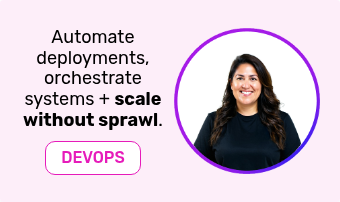The need for speed and agility within business has never been greater and low-code automation offers a transformative solution. By enabling anyone - from seasoned developers to non-technical team members - to design, deploy, and optimise workflows rapidly, it removes barriers and unlocks new opportunities for efficiency and innovation.
Low-code automation empowers businesses to streamline processes, reduce costs, and implement AI-led decision-making without the long development cycles of traditional approaches. Whether it’s automating repetitive tasks, enhancing collaboration, or delivering superior customer experiences; it frees up employees' time to spend on things that matter.
What is Low-Code Automation?
Low-code automation platforms are a game-changer for businesses seeking to optimise their processes without the complexity of traditional coding. It enables users to create, customise, and manage workflows using visual tools like drag-and-drop interfaces rather than requiring extensive programming expertise.
By leveraging low-code platforms, organisations can:
- Develop workflows faster
- Design automations using legacy technologies
- Empower non-technical staff to contribute
- Reduce dependency on IT teams
- Implement AI-led decision-making across existing stacks
- Streamline operations with minimal upfront effort
This approach makes automation accessible and scalable, allowing businesses to adapt to changing needs quickly and effectively.
How Does Low-Code Automation Work?
Low-code automation platforms simplify the workflow creation process, making it easier to digitise and optimise their processes. Here’s how they work:
- Intuitive Visual Builders: Users design workflows using drag-and-drop tools, selecting tasks, triggers, and decision points from pre-built components. These tools eliminate the need for coding knowledge, allowing anyone to create workflows.
- Integration with Existing Systems: Platforms connect seamlessly with existing software, databases, and APIs, ensuring a unified data flow across your organisation.
- Testing and Deployment: Workflows are tested within the platform to identify potential issues. Once refined, they can be deployed instantly across teams or systems.
- Real-Time Optimisation: Advanced platforms incorporate intelligent features like real-time monitoring and AI-driven insights, enabling workflows to self-optimise based on performance data.
Different types of workflows.
Workflows can vary based on their purpose and complexity. Understanding these can help you select the right automation approach:
- Basic Task Automation: Simple workflows that automate repetitive tasks, such as sending email notifications, importing and distributing data, or approving expense requests.
- Process Automation: More complex workflows that involve multiple steps and interactions across teams or systems, such as onboarding new employees or managing supply chains.
- Intelligent Workflows: These go beyond traditional automation by integrating AI and machine learning to analyse data and adapt workflows in real time. (For more details, explore our Intelligent Workflow Automation blog.
- End-to-End Automation: Comprehensive workflows that span the entire lifecycle of a process, from initiation to completion, ensuring seamless execution without human intervention.
Interested in learning more about AI Agents? They can be used to create and amend Intelligent Workflows rapidly using prompts. View our complete guide to AI Agents to find out more.
Top Low-Code Automation Platforms.
When it comes to low-code automation, numerous platforms offer unique features and benefits. Here are some leading providers:
- Rayven: Combines low-code simplicity with advanced capabilities like real-time monitoring, AI integration, and seamless system connectivity. Our platform is unique in combining its universal integration, real-time data processing, and complete app development functionality, alongside workflow automation; meaning you can do a lot more with your workflows than with other platforms. What's more, it's designed for scalability, affordability, and ease of use making it ideal for businesses of all sizes.
- OutSystems: Known for its robust development environment, OutSystems enables users to build enterprise-grade applications and workflows.
- Zapier: Focused on connecting apps and automating simple workflows, Zapier’s ease of use makes it popular among small businesses and non-technical users looking for ultra-simplicity (although at a higher, per-zap cost).
- Appian: Offers low-code tools for creating business process applications with a focus on scalability and integration with legacy systems.
- Microsoft Power Automate: A versatile tool that integrates seamlessly with the Microsoft ecosystem, enabling users to automate workflows across Office 365 and other applications.
- Mendix: Provides a comprehensive low-code development platform with tools for building both workflows and custom applications.
What to Look for in a Low-Code Automation Platform.
Choosing the right platform is critical to maximising the benefits of low-code automation. Here are key factors to consider:
- Ease of Use: Look for a platform with an intuitive interface that enables non-technical users to design and manage workflows effortlessly.
- Integration Capabilities: Ensure the platform can connect with your existing systems, databases, and APIs for a seamless data flow.
- Scalability: Choose a solution that grows with your organisation, supporting increased complexity and volume as needed.
- Real-Time Functionality: Platforms with real-time monitoring and AI-driven insights can optimise workflows dynamically, ensuring peak performance.
- Security and Compliance: Verify that the platform adheres to industry standards for data protection and compliance.
- Cost-Effectiveness: Evaluate pricing models to ensure the platform delivers value without straining your budget - be especially aware of data costs! These can add up, quickly.
- Support: A provider that offers training, documentation, and responsive customer support can ease the adoption process.
Why Choose Rayven for Low-Code Automation?
Rayven stands out as a premier low-code automation platform, combining user-friendly tools with powerful capabilities to transform your workflows. Here’s why it’s the ideal choice:
- No-Code/Low-Code Simplicity: Anyone in your organisation can create and manage workflows, reducing dependency on specialised IT skills. Use drag-and-drop or, if you need the ability to inject custom code, do so - the choice is yours.
- Advanced Features: From real-time data analysis to AI integration - all native within the platform - Rayven supports intelligent workflows that adapt to your business needs, as well as simple processes and automations.
- Seamless Integration: Rayven connects with any system, legacy or modern, ensuring a unified ecosystem without costly re-engineering.
- Scalable and Affordable: Designed to grow with your business, Rayven offers enterprise-grade features at a fraction of the cost of traditional platforms.
Ready to simplify your workflow creation and drive digital transformation? Get in touch with Rayven today and discover how our low code automation platform can revolutionise your operations.




















































